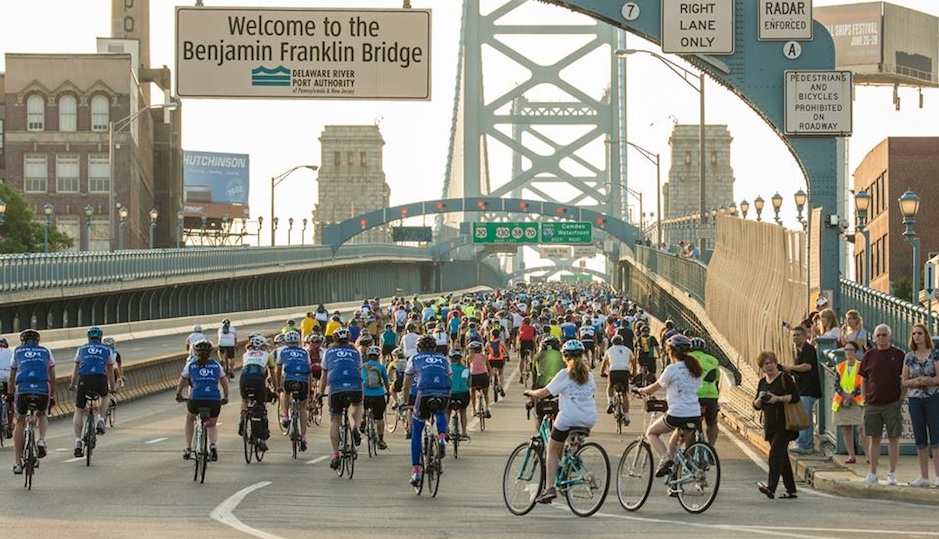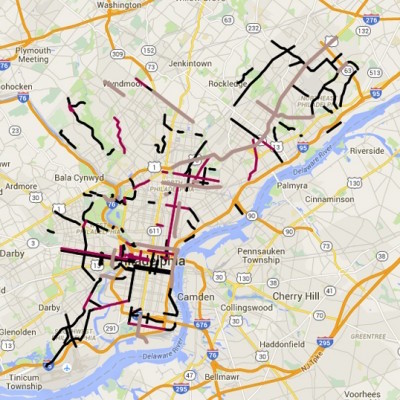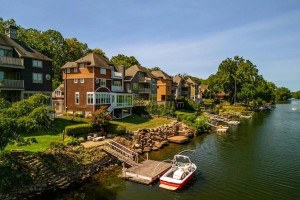Center City West Named America’s Most Bikeable Downtown

Bicycle transportation advocates would love for this to be a typical evening commute from Philly to South Jersey. Still, they have plenty to be proud of with Bike Score’s ranking of Center City West as the nation’s most walkable downtown.| Photo via Facebook
This is Bike to Work Week, and while I left my three-speed at home in Germantown and took SEPTA to work today,* I generally consider bicycling as practical transportation a great idea: you stay healthy and fit while performing a task you need to do every day.
The people at Walk Score, a Redfin subsidiary based in Seattle, say that there’s no place better for biking to work than the part of Center City that includes Philadelphia’s offices. According to the Bike Score rankings, Center City West — the area from Broad Street to the Schuylkill and Pine to Vine streets — is the nation’s most bikeable downtown, with a Bike Score of 96.4 out of a possible 100.
In annoucing the ranking on the Redfin blog, post author Keena Bean cited figures provided by Clarena Tolson, deputy managing director for transportation and infrastructure in the Kenney administration. Specifically, she noted that the city has more than 440 miles of bike lanes, the most bike lanes per square mile of any large city in the country.
City Hall, naturally, patted itself on the back over the announcement. Noting that Walk Score had rated Philadelphia the nation’s fourth most walkable city a few weeks back, Mayor Jim Kenney said in a news release, “Philadelphia’s walkability has always been one of city’s strongest assets for residents and visitors alike, and today we celebrate our bikability with a growing number of Philadelphia users and facilities. My goal is to continue to not just increase ridership but to increase it across all neighborhoods in our city.”
That’s a goal the Bicycle Coalition of Greater Philadelphia shares. Executive Director Sarah Clark Stuart pointed to the quality of the bike infrastructure leading into and out of Center City West as a major contributor to the district’s high Bike Score.
“The buffered bike lanes on Spruce and Pine streets are one important piece of infrastructure,” Stuart said. “The Schuylkill River Trail is also an important corridor leading into and out of the city, and in 2014, the boardwalk extended it to the South Street Bridge, so now there’s a feeder corridor from West Philadelphia into the city.
“The Schuylkill Banks trail has 30,000 users, pedestrians and bicyclists, each week.” The figure comes from automatic traffic counters installed along the trail.
“Bike share has also added a new component of both infrastructure and encouragement for bicycling in the area,” she continued. “There are 18 bike share stations between Christian and Spring Garden streets west of Broad.”
All of this adds up to a high rate of bike commuting in the city. “Based on 2014 bicycle commuting figures, Philadelphia had a bike commuting rate of 5.61 percent,” she said. That figure puts the city in about the middle of the pack of 25 cities with the highest bike commuting rates, on par with places like San Francisco and Santa Cruz in California. (The bike commuting mode split in the 25 cities ranged from a low of about 4 percent to a high around 9 percent in 2012, the latest year for which the Bicycle Coalition had data on all the cities.)
And both the city and the Bicycle Coalition are working to further improve that infrastructure and raise that bike-commuting level. Indego, the city-owned, Independence Blue Cross-sponsored bike share network, is on track to add 30 more bike share stations to its network this year and is expanding its reach further into North, West and South Philadelphia. “This year we are looking forward to bringing Indego to more places, connecting with more people, and really making it part of the fabric of Philadelphia,” Aaron Ritz, co-director of the Indego program for the city, said in the news release.

This map shows the city streets where the Bicycle Coalition is advocating for improved bike infrastructure ranging from buffered to protected lanes.
Stuart is all for that and more. “We want bike commuting to spread beyond Center City, West and South Philadelphia to North Philly, Northeast Philly, Southwest Philly and beyond,” she said. “Two important things will help do that: better bike infrastructure in those neighborhoods and more bike share stations to encourage bicycling.”
Stuart noted that the streets of Center City and West Philly all favored bike use as well. “One reason why Center City and West Philadelphia have such high bike commuting rates is because they are employment centers,” she said. But they also have largely narrow streets and slower moving traffic. As you move out, the streets widen and traffic flows faster.” Protected bike lanes, she said, would increase the comfort level of would-be riders on those wider streets and encourage even more bike use. The city recently received a $300,000 grant from PennDOT’s Transportation Alternatives Program that will be used to create the city’s first protected bike lanes.
*Walk Score hasn’t yet released Transit Score rankings for the nation’s cities, but Center City Philadelphia would also rank highly on that metric: Center City West’s Transit Score is 100. Center City’s residential sub-neighborhoods also rank highly: Rittenhouse Square and Washington Square West have Walk, Bike and Transit Scores in the “Paradise” range (90-100).
What’s this story doing in the real estate section? Read on.
Follow Sandy Smith on Twitter.


